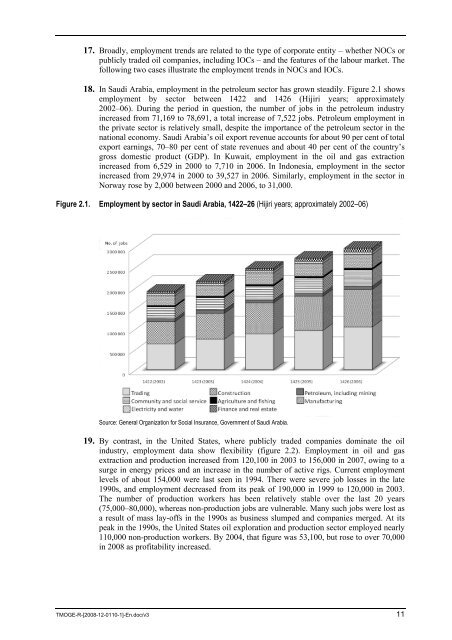wcms_161662
wcms_161662
wcms_161662
You also want an ePaper? Increase the reach of your titles
YUMPU automatically turns print PDFs into web optimized ePapers that Google loves.
17. Broadly, employment trends are related to the type of corporate entity – whether NOCs or<br />
publicly traded oil companies, including IOCs – and the features of the labour market. The<br />
following two cases illustrate the employment trends in NOCs and IOCs.<br />
18. In Saudi Arabia, employment in the petroleum sector has grown steadily. Figure 2.1 shows<br />
employment by sector between 1422 and 1426 (Hijiri years; approximately<br />
2002–06). During the period in question, the number of jobs in the petroleum industry<br />
increased from 71,169 to 78,691, a total increase of 7,522 jobs. Petroleum employment in<br />
the private sector is relatively small, despite the importance of the petroleum sector in the<br />
national economy. Saudi Arabia’s oil export revenue accounts for about 90 per cent of total<br />
export earnings, 70–80 per cent of state revenues and about 40 per cent of the country’s<br />
gross domestic product (GDP). In Kuwait, employment in the oil and gas extraction<br />
increased from 6,529 in 2000 to 7,710 in 2006. In Indonesia, employment in the sector<br />
increased from 29,974 in 2000 to 39,527 in 2006. Similarly, employment in the sector in<br />
Norway rose by 2,000 between 2000 and 2006, to 31,000.<br />
Figure 2.1. Employment by sector in Saudi Arabia, 1422–26 (Hijiri years; approximately 2002–06)<br />
Source: General Organization for Social Insurance, Government of Saudi Arabia.<br />
19. By contrast, in the United States, where publicly traded companies dominate the oil<br />
industry, employment data show flexibility (figure 2.2). Employment in oil and gas<br />
extraction and production increased from 120,100 in 2003 to 156,000 in 2007, owing to a<br />
surge in energy prices and an increase in the number of active rigs. Current employment<br />
levels of about 154,000 were last seen in 1994. There were severe job losses in the late<br />
1990s, and employment decreased from its peak of 190,000 in 1999 to 120,000 in 2003.<br />
The number of production workers has been relatively stable over the last 20 years<br />
(75,000–80,000), whereas non-production jobs are vulnerable. Many such jobs were lost as<br />
a result of mass lay-offs in the 1990s as business slumped and companies merged. At its<br />
peak in the 1990s, the United States oil exploration and production sector employed nearly<br />
110,000 non-production workers. By 2004, that figure was 53,100, but rose to over 70,000<br />
in 2008 as profitability increased.<br />
TMOGE-R-[2008-12-0110-1]-En.doc/v3 11














